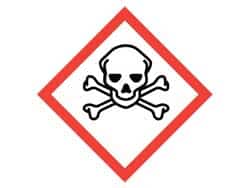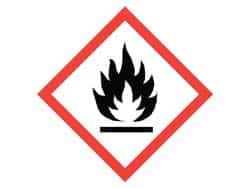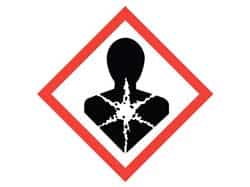Online OSHA Hazard Communication / GHS Training Courses
Home Online OSHA Training Courses Online OSHA Hazard Communication / GHS Training Courses
Satisfy OSHA Requirements for Training on GHS, SDS's, and Labels
Meet OSHA’s mandatory Hazard Communication / GHS training requirements with our online Haz-Com training courses. These online Haz-Com training courses include the additional training required for employees when the Globally Harmonized System of Classification and Labeling of Chemicals, also known as the GHS, was adopted into the OSHA Hazard Communication standard in 2012.
Covers training on how to read and understand the new GHS-compliant container labels and Safety Data Sheets (SDS’s). Available for General Industry and for Construction. A Hazard Communication refresher training version of this course is also available. Print your personalized Hazard Communication training certification upon successful completion of the course.
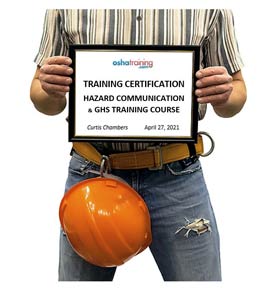
Answers to Frequently Asked Questions About Hazard Communication Training
An OSHA Expert with extensive experience, training, and education in OSHA compliance matters provides answers to questions commonly asked about the OSHA Hazard Communication standards. The information provided in this section about the OSHA Haz-Com standard is for GENERAL INFORMATIONAL purposes only, and is NOT TO BE CONSIDERED LEGAL ADVICE. Employers and others reading this information are advised to contact a qualified safety professional, if needed, about the FAQ’s below.
OSHA published their original Hazard Communication standard in 1983. This standard, which was one of the first major new standards added since OSHA initially published rules in 1971, was often referred to as the “Employee Right to Know” standard, because its purpose was to insure employees had access to information about the hazards of chemicals and products they were exposed to at work. More specifically, employers had to ensure that containers of potentially harmful chemicals and products were labelled with certain information about the identify of their contents and their associated hazards. Employers were also required to gather and make available Material Safety Data Sheets, or MSDS’s, for employees to review, and provide training to educate employees about the hazards of the chemicals and products they used at work, as well as the precautions necessary to protect themselves.
The original OSHA Hazard Communication standard was not without its faults. While the original OSHA Hazard Communication standard, also referred to as the Haz-Com standard, mandated that manufacturers and distributors provide specific health and safety-related information about their chemicals and products on container labels, there was no specific format that had to be followed to make up the labels. Furthermore, the OSHA Haz-Com standard mandated that Materials Safety Data Sheets, or MSDS’s, had to be available for employee review, but again, there was no specific format that had to be utilized by the various manufacturers and distributors when they created their MSDS’s.
As you can imagine, all these variations in container labels and MSDS’s led to a lot of frustration among workers. So eventually, it was determined that the Haz-Com standard, as written, was not meeting its original intent, which was to help employees know exactly what they were working with, how it could harm them, and most importantly, how to protect themselves. So, nearly 30 years later, in 2012, OSHA revised their Hazard Communication standard.
A major part of that revision was to adopt what was known as the GHS, or “Globally Harmonized System of Classification and Labelling of Chemicals”. The GHS standard adopted by OSHA into their Haz-Com standard was originally developed by The United Nations. The GHS is a Standardized system, which means that, once fully implemented, container labels for chemicals and products from around the world will be standardized. In addition, chemical manufacturers and distributors now must develop and distribute Safety Data Sheets, or SDS’s, in lieu of MSDS’s. These new documents also have to provide important health and safety-related information, but in a very specific order and format.
Furthermore, the revised Haz-Com standard now requires that employers train their employees on how to read and understand the new GHS labeling system and Safety Data Sheets. With these improvements, the new nickname for the OSHA hazard communication standard changed from the “employee right-to-know” standard to the “employee right-to-understand” standard.
Yes. Employees must be trained on the employer’s Hazard Communication Program, the location of all written materials required by the standard, how to identify hazards and symptoms of over-exposure associated with the chemicals to which they are exposed, and how to protect themselves from those hazards. Hazard Communication training must be provided to affected workers upon initial assignment to any job with a reasonable potential exposure to chemical hazards, when there is a change in an employee’s job duties that represent an opportunity for exposures to new chemicals, and when there are new products introduced into the workplace that present new hazards to which workers were not already trained. Some State Plan OSHA programs also require annual refresher training on Hazard Communication.
The OSHA Hazard Communication standard applies to any potentially hazardous chemical or product present in the workplace that employees may be exposed to under normal conditions of use, or in a foreseeable emergency. Examples include, but are not limited to:
- Chemicals and products that are an Irritant to your skin, eyes, or respiratory tract;
- Chemicals and products that are Corrosive, meaning they can burn or destroy human tissue;
- Chemicals and products that are Toxic, or poisonous to your system;
- Chemicals and products that are a Carcinogen, which means they can cause cancer;
- Chemicals and products that are classified as a Teratogen or a Mutagen, which can affect your unborn baby, or future generations of your offspring;
- Chemicals and products that are classified as either a Flammable or Explosive;
- Chemicals and products that are classified as an Oxidizer, meaning it can make combustible items ignite or burn much more rapidly;
- Chemicals and products classified as a Pyrophoric, meaning they can spontaneously ignite when exposed to air; and,
- Compressed gasses, which can sometimes displace oxygen if they leak into an enclosed area, and may result in a dangerous projectile if the cylinder is ruptured.
The OSHA Haz-Com standard does NOT apply to food and alcoholic beverages which are to be sold, used, or prepared in a retail establishment such as a grocery store, restaurant, or bar. It also does not apply to drugs, such as tablets or pills, when they are in their solid, final form and suitable for direct administration to a patient, or which are packaged by the chemical manufacturer for sale to consumers in a retail establishment. Cosmetics, when they are packaged for sale to consumers in a retail establishment are not covered by the OSHA Haz-Com standard, nor are hazardous wastes, which are regulated by the EPA, or biological hazards, such as medical waste;
Non-processed wood or wood products – with the operative term here being non-processed – are not covered by the OSHA Hazard Communication standard. However, wood or any wood products which have been treated with a hazardous chemical – such as a preservative, as well as wood or any wood products which may be subsequently sawed or cut, thereby generating dust, are NOT exempted from the Haz-Com standard.
The Haz-Com standard also does NOT apply to consumer products used in the workplace for the purpose intended by the product’s manufacturer or importer, so long as it is used in a duration and frequency of exposure which is not greater than the range of exposures that could reasonably be experienced by ordinary household consumers when used for the purpose intended. For example, most homeowners probably have a bottle of tile cleaner, which are typically classified as a chemical irritant, in their home. And they may use it once every week or two to clean some tiles in the kitchen or bathrooms. So, if you have the same tile cleaner in your workplace and only use in in a similar manner and frequency as a normal consumer would at home, then the tile cleaner would not be covered by this standard. However, if the same bottle of tile cleaner is used in a work setting by an employee at a much greater frequency, for example, someone on a janitorial staff or clean-up crew who uses the product to clean tile every day of the week, then the product and its use would be covered by the OSHA Haz-Com standard.
As this consumer use exception is very subjective, most employers opt to include ALL potentially hazardous chemicals and products into their Haz-Com program, even if they qualify for one of these exceptions.
Container labels are the employee’s first line of defense when it comes to understanding what they are working with and how it can cause them harm. So, OSHA now requires the following information appear on all container labels of potentially harmful chemicals and products, per the GHS format adopted by OSHA:
- Product or Chemical Identifier. This might be the name of the product itself, or, the specific name of the chemical contained. This information will also match up to the Safety Data Sheet, or SDS, for the product.
- Signal Word. There are only two that are used in the GHS system; either the word DANGER, which indicates a relatively severe or immediate hazard, or WARNING, which indicates a less severe, but still potentially harmful, level of hazard.
- Hazard Statements. These standardized hazard statements give employees a quick warning about the hazards associated with the product, and differ according to the classification and category of hazard (or hazards) presented by the product.
- Precautionary Statements. In general, they convey information about how to prevent or lessen exposure to the product, as well as considerations for storage of the product, as well as first aid procedures to be used when accidental over-exposure occurs. There may also be information about how to respond to an accidental spill or release of the product, as well as information about its proper disposal.
- Supplier Information. This is where you will find the name of the manufacturer or distributor of the product, as well as their street address and telephone number.
- Pictograms. These are standardized icons that let workers know about the hazards of the product in the container.
On some container labels, you may see Supplemental information about the product, such as directions for its use, and possibly an expiration date for the product.
There are currently nine different Pictograms used in the GHS container labeling system and on safety data sheets (SDS) required by OSHA. Each one depicts a different health or safety hazard applicable to the particular product. Some labels or SDS’s may have only one pictogram because there is only one class of hazard associated with that product; However, most labels and SDS’s will display multiple Pictograms.
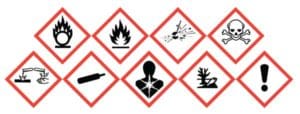
The “FLAME” pictogram, which depicts a flame, is associated flammable liquids, solids, and aerosols. This pictogram will also appear on products that emit flammable gases, are pyrophoric (which means the chemical can possibly ignite within minutes of being exposed to air), are self-heating chemicals, self-reactive chemicals, or organic peroxides (which are found in many catalysts and curing agents).
“OXIDIZERS” will be identified by the pictogram displaying a flame over a circle. While similar looking to the FLAME pictogram, oxidizers are actually materials that cause or contribute more oxygen to the combustion process, making other materials burn much more rapidly than they normally would. And in some extreme cases, they can even ignite combustible materials when subjected to force or friction. So, these products should not be stored near flammable or combustible materials, nor used or stored near flame or spark-producing equipment or activities.
An “EXPLODING BOMB” appears on the pictogram used to denote products that are explosive. This symbol will also be found on labels for self-reactive products, and on labels for organic peroxides.
The “GAS CYLINDER” pictogram will appear on labels on cylinders containing compressed gases under pressure. Care must be used when handling these cylinders because in the right conditions, a broken regulator or valve could cause the cylinder to become a flying projectile. Also, when a compressed gas leaks into an enclosed space, such as through a leaking hose or cracked valve, the gas can fill up that space and cause an oxygen-deficient atmosphere in some cases. Also, some gasses are liquefied under pressure, so they can be pumped into a cylinder. Sometimes these liquified gases rapidly expand and become very cold when released from the cylinder, and can even cause frostbite injuries if they make contact with any part of your body.
The “CORROSIVE” pictogram appears on labels and SDS’s associated with corrosive chemicals and products. Obviously, getting something corrosive on your skin could cause a chemical burn, and the same can be said if you get any in your eye. But these products are also corrosive to metals, which means they could cause containers and other articles made from metal to corrode and break or leak.
The “SKULL AND CROSSBONES” pictogram depicts chemicals and products that present an acute toxicity hazard. “Toxic” means it can cause severe or even deadly poisoning if proper storage and handling practices are not followed. And “Acute” means the effects happen relatively quick, as opposed to over a long period of time.
The “HEALTH HAZARD” pictogram identifies chemicals and products that can potentially cause health problems with exposures over an extended period of time. These include carcinogens, which can cause cancer, mutagens, which can cause alterations in your DNA and possibly affect your offspring, reproductive hazards, which could affect the ability of women or men to have healthy children, respiratory sensitizers, which could cause you to have allergic reactions when exposed to that chemical at even low levels after you have been initially overexposed, chemicals that cause damage to and/or affect the function of certain organs, and aspiration toxicity hazards, which could lead to the development of chemical pneumonia.
The “EXCLAMATION MARK” pictogram is associated with several chemicals and products that, relatively speaking, represent “lesser” levels of health effects, but that still require you to take precautions. For example, many chemicals and products are considered an irritant to your skin or eyes, while others can have a similar effect on your respiratory tract when they are inhaled. Chemicals in this category can also can cause your skin to break out after subsequent exposures. Some chemicals classified as irritants can have an acute effect on your health – that, while less severe that those identified by the “Skull and Crossbones” pictogram, but still require you to utilize precautions so you don’t suffer any ill effects. Chemicals that have a narcotic effect on your central nervous system are commonly categorized in the exclamation mark group, as are any products that can have a negative effect on the ozone layer (although OSHA does not enforce the use of this pictogram for this purpose because it does not directly affect the health of workers).
And finally, “TOXIC TO PLANTS AND AQUATIC ANIMALS” pictogram appears on labels and SDS’s of chemicals and products that are toxic to plants and aquatic animals. However, OSHA does not enforce the use of this pictogram since it does not directly affect the health of exposed workers.
Chemicals and products regulated under the OSHA Hazard Communication standard will display at least one, but in many cases two or more of these pictograms, on the labels on containers of chemicals and products covered by the OSHA Hazard Communication standard, as well on safety data sheets.
The revised Hazard Communication standard replaced Materials Safety Data Sheets (MSDS’s) with a similar document called a Safety Data Sheet (SDS). The SDS’s incorporate GHS formatting requirements. In the GHS format now required for all safety data sheets, each one will be broken down into 16 separate sections. The sections will always have the same titles, and will always appear in the same order.
Here is an explanation of the information that must now appear on GHS-compliant Safety Data Sheets, beginning with section 1:
Section 1 on GHS-compliant Safety Data Sheets is titled “IDENTIFICATION”. This is where you will find the name of the product as it appears on the container label, and in some cases, applicable synonyms or chemical classification codes used for the chemical. You will also find supplier information, such as the name of the manufacturer or distributor of the product, as well as their street address and an emergency contact information. And as was the case with container labels, some SDS’s may display supplemental information about the product, such as directions for its use, and possibly an expiration date for the product. This information should match up with the information appearing on the container label for that same product
Section 2 of a Safety Data Sheet is titled “HAZARD IDENTIFICATION”. Here, you will find the GHS Hazard Classifications for the product, including those for all Health hazards and physical hazards associated with that product, plus the individual hazard categories. You will also find the appropriate Signal Word associated with the product (either Warning, or Danger). You will also see listed all applicable Hazard Statements, which are standardized statements that give employees a quick warning about what hazards are associated with the product, and differ according to the classification and category of hazard (or hazards) presented by the product. This section of the SDS also displays applicable Precautionary Statements. These, too, are standardized in the GHS labeling system, and in general, convey information about how to prevent or lessen exposure to the product’s hazards. This section also displays all applicable Pictograms, which, as we discussed earlier in the section on labeling. This section is also where you will find any information about any unclassified hazards associated with the product, such as if it generates combustible dust when you cut or grind it.
Section 3 of Safety Data Sheets, titled “COMPOSITION AND INFORMATION ON INGREDIENTS”, identifies the chemical names of the ingredient(s) contained in the product. This could be a single chemical name for a pure substance, or two or more chemicals if the product is a mixture or contains impurities or stabilizers that contribute to the hazards of a product. You will also find the common name and any synonyms used for the product, as well as the applicable Chemical Abstracts Service (or CAS) number. When the product is a mixture of hazardous chemicals, the SDS will list the chemical name and concentration of all ingredients which are classified as health hazards, and will be expressed in either percentages or ranges by weight. And for chemicals where a trade secret is claimed, there will be a s statement that the specific chemical identity and/or its composition has been withheld as a trade secret.
Section 4 on a Safety Data Sheet describes the recommended initial “FIRST AID MEASURES” that should be administered by untrained responders to anyone who has experienced a chemical exposure. This information includes a list of any instructions for aid for different routes of exposure, such as contact with skin and eyes, inhalation, and ingestion. Also included will be a description of the most common symptoms of over-exposure, including those which are acute, or delayed, and recommendations for immediate medical care and special treatment that may be needed in some cases.
Section 5 is titled “FIRE FIGHTING MEASURES”, and as the name implies, it provides manufacturer’s recommendations for fighting a fire involving their product. Here you will find a recommendation for the most suitable type of equipment for extinguishing a fire involving the product, as well as information about fire extinguishing media that are not appropriate for use on a particular chemical or product. You will also find details about any specific hazards that may occur when the product is involved in a fire, as well as any hazardous byproducts that might develop during the combustion of the chemical or product. And in some cases, you may see recommendations on special protective equipment or precautions to be utilized by fire brigade members or firefighters.
Section 6, titled “ACCIDENTAL RELEASE MEASURES”, provides the manufacturer’s recommendations for responding to spills, leaks, or unintended releases of their product, including response measures for containment of the product, and cleanup methods recommended to prevent or minimize exposure for response personnel, including specific recommendations for protecting personnel involved in the response from specific hazards, such as sources of ignition or lack of ventilation, recommended personal protective equipment to prevent personnel from being contaminated during the response, and emergency procedures, including instructions for evacuations of response personnel, when needed, as well as others located nearby.
Section 7 provides information pertinent to “SAFE HANDLING AND STORAGE” of the product. The required information consists of precautions for safe handling to prevent or minimize the release of the chemical into the environment, and to prevent exposure or contamination for personnel handling the product. There may also be recommended hygiene practices; for example, prohibitions against smoking, eating, or drinking in or near areas where when the product is being handled, and washing your hands after handling the product. And when the product is being stored or used, there may be a need to avoid certain incompatible products, or agents such as high heat, or water, which might cause the product to react.
Section 8 of the SDS, titled “EXPOSURE CONTROLS AND PERSONAL PROTECTION”, lists the OSHA Permissible Exposure Limits (or PELs) for exposure to the chemical, or chemicals, contained in the product. These mandatory limits dictate when it will be necessary to utilize controls such as ventilation systems or respiratory protection devices to protect workers from the ill effects of over-exposure to the chemical. There may also be listings for voluntary Threshold Limit Values (TLVs) established by the American Conference of Governmental Industrial Hygienists (ACGIH), or similar limits recommended by other groups. This section will also list appropriate engineering controls, where applicable, such as recommendations for exhaust ventilation systems or enclosures to contain emissions. And, of upmost importance, you will find the manufacturer’s recommendations for personal protective equipment (or PPE), including any special requirements for providing certain types of PPE, such as respirators, goggles, or gloves.
Section 9 of the Safety Data Sheet identifies all applicable “PHYSICAL AND CHEMICAL PROPERTIES“ associated with the product. While most workers may not care about this type of information, safety managers and engineers may have a need-to-know specific information about the product, where applicable, including but not limited to:
- What does the chemical or product smell like?
- What does it look like?
- At what temperature does it freeze, or boil?
- At what temperature the product emits enough vapors catch on fire, or, cause an explosion?
- How much vapor must be present at the point of ignition to burn cause an explosion?
- Are the vapors heavier than air, or lighter?
- And, when dealing with corrosive products, it will be necessary for some persons to know the pH of the chemical.
Section 10 of an SDS is titled “STABILITY AND REACTIVITY”. Here you will find important information on any materials which may be incompatible with the product, as well as any conditions to avoid during storage and handling, such as temperature extremes, shock, and static discharge. There will also be information about any conditions that could cause the chemical to react or polymerize, as this could cause the product to release excess pressure or heat, or create decomposition products that could be harmful to exposed workers. And when applicable, this section will also provide information about any stabilizers that may be needed to maintain stability of the product.
Section 11 of a Safety Data Sheet, titled “TOXICOLOGICAL INFORMATION”, lists the known routes of exposure the chemical can get into your system, including inhalation, ingestion, and skin and eye contact. Also listed are the effects of over-exposure to the product, which include the acute and chronic effects, applicable target organ effects, and a description of symptoms associated with over-exposure to the product. There will also be specific measures of toxicity, where applicable, such as LD50 – that is the estimated amount of a substance expected to kill half of exposed test animals in a single dose. And, if a chemical is listed as an actual or potential carcinogen, that information will also be revealed in this section.
Section 12 – titled “ECOLOGICAL INFORMATION”;
Section 13 – “DISPOSAL CONSIDERATIONS”;
Section 14 – “TRANSPORT INFORMATION”; and,
Section 15 – “REGULATORY INFORMATION”, all deal with requirements regulated by other entities, such as the EPA or the DOT. Therefore, these sections are not regulated by OSHA, but appear in the SDS to be consistent with the GHS format for safety data sheets, and to provide information needed to comply with other regulations.
And finally, Section 16 of Safety Data Sheets, titled “OTHER INFORMATION”, lists details such as the date the Safety Data Sheet was prepared, if this is the original version issued, or a revised version, and in some cases, an overview of any changes that were made during the last revision. And sometimes, a manufacturer or distributor may choose to put other information about their product in this section, as well as any applicable disclaimers.
Safety Data Sheets (SDS) must be maintained at the worksite by the employer (or in the case of a multi-employer workplace such as a construction site, the employers), and be made available to affected employees and their representatives (e.g.: union representatives) who wish to review them. There are several options to achieve compliance with this requirement. One commonly used method is to keep a copy of each and every Safety Data Sheet in a binder that is placed in the workplace. Another option is to scan all SDS’s and make them available via a computer terminal, or utilize a service that maintains them for the employer via an online program or app that employees can access from the workplace. However, employers choosing the computer or internet route should also keep a hard copy of each SDS in the workplace in case of a power outage or other technical barrier to the electronic copies of SDS’s.
In addition to Safety Data Sheets (SDS’s) for all hazardous chemicals and products at the site, OSHA’s Haz-Com standard requires employers to maintain other written materials on site, including the organization’s written Hazard Communication program. This site-specific written program, which is typically included in the company safety manual, outlines the steps for how the organization will implement their Haz-Com program at the site. One important part of the written Haz-Com program is the written chemical inventory. This document lists of all covered chemicals and products located at the work site which are covered by the OSHA Haz-Com program, and must be updated whenever a new chemical or product is brought onto the worksite. These documents are all required to be available for employee review.
OSHA Compliant Hazard Communication Training Courses
Get you OSHA Hazard Communication training certification at your own pace. On-demand Hazard Communication training courses available for general industry and for construction, as well as Haz-Com annual refresher course.
More Hazard Communication / GHS Training Resources
- Make sure your Written Hazard Communication Program has been updated to reflect Hazard Communication / GHS-related information required by OSHA. Download your FREE Written Hazard Communication Program here – this link opens a Word document that you can download and then revise/customize to make specific to your company or organization..
- OSHA Training Services also offers on site training services. Have one of our OSHA-authorized Outreach trainers come to your site to conduct OSHA training for your workers. We will document all training and give certificates of completion to each trainee – CLICK HERE
- In addition, we have a page that lists all training requirements listed in the OSHA Hazard Communication standard (1910.1200). Check this page out to make certain you have identified all your training obligations under this standard – CLICK HERE

